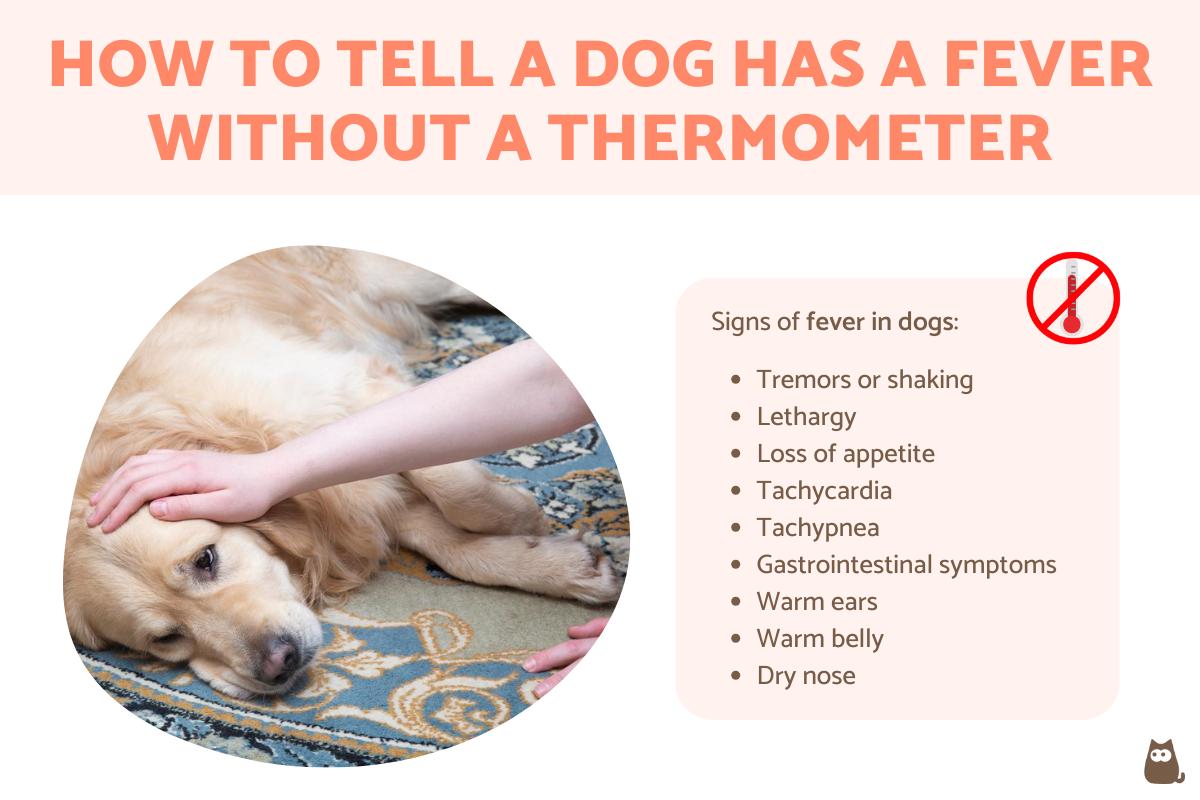How Can You Tell If a Dog Has a Fever Without a Thermometer?



See files for Dogs
Fever in dogs is a symptom of various diseases, whether relatively mild or life threatening. It is part of the dog's immune response, resulting a significant increase in the dog's internal body temperature. The response of the immune system is provoked by various medical conditions, such as infections and inflammations. These can be caused by pathogens such as bacteria, viruses, fungi or parasites. This enhanced immune function is necessary to fight the diseases, but it also puts their organism at risk. Determining whether a dog has a fever is carried out by taking their temperature, but what if we don't have a thermometer at hand?
AnimalWised finds out how can you tell if a dog has a fever without a thermometer? To do this, we look at the signs and symptoms of fever in dogs, as well as how you can help them through this experience.
Can you tell if a dog has a fever without a thermometer?
The normal body temperature of a dog is in the range between 101°F and 102.5°F (38.3°C and 39.2°C). Although a dog can be sick without having changes in their body temperature, they will not have a fever. This is because body temperature is only one of the vital signs that will indicate the health status of the dog.
Generally speaking, illnesses will cause a change in body temperature. When it is too low, the dog is hypothermic and they are hyperthermic when they are too high. Hyperthermia is not the same as fever as it is the inability of the dog to get rid of excess heat, usually arising from external factors. Fever is an elevated body temperature as part of their immune response and is usually caused by internal factors.
Fever occurs when the animal is experiencing infections, inflammatory conditions, cancers and other canine diseases. However, this is not always the case. A dog can be sick without fever if they are affected by one of the following:
- Early stages of disease: sometimes a dog may be infected, but the early onset means it is not registering fever when we take the dog's body temperature.
- Localized problem: if the dog has a localized injury, infection or other health condition, it likely won't change their overall body temperature.
- Chronic condition: if a dog has an illness which is chronic and lasts for a prolonged period, their body temperature might remain level, despite having a health problem.
- Hormonal disorders: when a dog's hormonal system is not function properly, it can have serious repercussions on the dog's health without elevating their temperature to a fever. Endocrine disorders in dogs are commonly in this category.
In most other cases, the dog's illness will cause them to record a fever. Taking a dog's temperature is the only way to know their exact body temperature reading. While some may try to take their temperature in the armpit, the most accurate reading is rectal. However, you can tell if a dog has a fever without a thermometer. This is because when a dog has a fever, they will present other symptoms. You can identify whether your dog has a fever by observing for them.
In the next sections we see how to tell if a dog has a fever without a thermometer.
How to tell if a dog has a fever without a thermometer
We have already explained that a dog's normal body temperature is between 101°F and 102.5°F (38.3°C and 39.2°C). Although a definitive reading that determines fever is only diagnosed with a thermometer, the signs and symptoms of fever in dogs can confirm their body temperature is elevated. The most common reasons why a dog has a fever are the following:
- Infections: viruses, bacteria and fungi are capable of infecting your dog and causing diseases in it. In these cases, vomiting, diarrhea and/or runny nose may appear.
- Vaccine reactions: on occasion, your dog may register a fever after being administered vaccine. This is a totally normal response since their body is reacting to the vaccine. The fever in these cases usually lasts between 24 and 48 hours. Only if it persists or other symptoms appear might it be an adverse reaction, but these are very rare in dogs.
- Intoxication: if your dog has been poisoned or otherwise ingested a toxic substance, it is possible that fever may appear as a result. It is also likely we will see vomiting, apathy, tremors, dilated pupils, disorientation or paralysis, among other signs. In acute cases, the dog can go into toxic shock which seriously threatens their life.
- Inflammatory conditions: if your dog is experiencing an inflammatory process, it is likely that fever will be a symptom. This will depend on the type of inflammation, but may also observe pain, a refusal to be touched, poor gait and other signs of fever.
- Tumors: malignant tumors can also cause fever. Benign tumors do not usually cause fever, but they may influence processes such as secondary infections which can.
If you are wondering how to know if my dog has a fever without a thermometer, here are a series of symptoms that will help you identify if your dog could have hyperthermia:
- Tremors or shaking: this is a very common symptom when a dog has a fever, with the amount of trembling increasing the greater the fever.
- Lethargy: you will see they feel more tired, sleeping more and being reluctant to engage in activities they otherwise enjoy. This is due to their energy being used in the immune response, meaning they have less energy for even normal activities.
- Loss of appetite: when a dog has a fever, their gastrointestinal system is usually much more sensitive. They may feel nauseous at the thought of eating.
- Tachycardia: an increased heart rate, also as a result of their immune response.
- Tachypnea: increased respiratory rate.
- Gastrointestinal symptoms: it is possible for you to notice a change in their stool. They may appear more solid and dry. Learn more with our article on the causes and treatment of small dog constipation.
- Warm ears: a dog's ears will become warmer to the touch when they have a significant fever. This is not the only reason, so take a look at why a dog has swollen ears to learn more.
- Warm belly: a dog's belly will also usually feel warmer when they have a significant fever. This can also be caused by other issues such as exposure to the sun.
- Dry nose: the nose may appear dry and hot when a dog has a fever, but again it does not indicate with certainty that this is the case if it is the only symptom. Learn more with our article on why a puppy has a dry nose.
As you can see, these symptoms on their own won't necessarily affirm a dog's fever without a thermometer. However, if we see them combined, it is likely the dog is feverish and needs to be taken to a veterinarian.

What should I do if my dog has a fever?
If you suspect that your dog has a fever and it is not a reaction to a vaccine, it is best to go to the veterinarian. They will be able to run a differential diagnosis and confirm the underlying cause of the fever. Prompt intervention is key and the more we leave it, the worse the prognosis may be. Since fever accompanies infections and inflammatory conditions, it is a symptom of a condition which could be fatal.
As you prepare to take the dog to a veterinary center, you can manage the dog's fever by doing the following:
- Apply cold cloths or compresses to their abdomen to keep the dog feeling too hot. If they are too cold, it is advisable to wrap them in a towel so that the cold is not applied directly to the dog's body.
- Wet their paw pads and ears with cold water as well, this usually helps reduce fever.
- They need to drink water in small amounts to prevent dehydration, especially if they are vomiting.
- Wet their entire body progressively with fresh water.
- Keep the dog in a cool and quiet place. Sometimes it is possible to confuse shivering with cold and it is common to try to warm the dog up, but if you are facing a febrile process this could worsen the problem by further raising its body temperature. For this reason, it is also important to make sure of the exact temperature of their body.
- Under no circumstances should you give medication, especially not human medicines. This could cause more serious problems in the dog's body. Any medication should be prescribed by the veterinarian after providing an accurate diagnosis.
- If the dog's fever is an infection, the veterinarian may need to stabilize them. This may include fluid therapy to prevent dehydration, antibiotics to kill bacterial pathogens or other treatments specific to the underlying cause of fever in the dog.
If the fever lasts a day, in principle there is no need to worry. It is advisable to go to the veterinarian anyway to rule out any condition or disease that could worsen in the future. If your dog has had a fever for more than two or three days or the temperature is above 105°F (40.5°C), do not hesitate to go to the vet. This indicates there is a serious systemic problem with the dog.
Although here we have explained how to know if a dog has a fever without a thermometer, we should ideally take an accurate reading. Check out the video below to see how it is done properly:

This article is purely informative. AnimalWised does not have the authority to prescribe any veterinary treatment or create a diagnosis. We invite you to take your pet to the veterinarian if they are suffering from any condition or pain.
If you want to read similar articles to How Can You Tell If a Dog Has a Fever Without a Thermometer?, we recommend you visit our Infectious diseases category.






